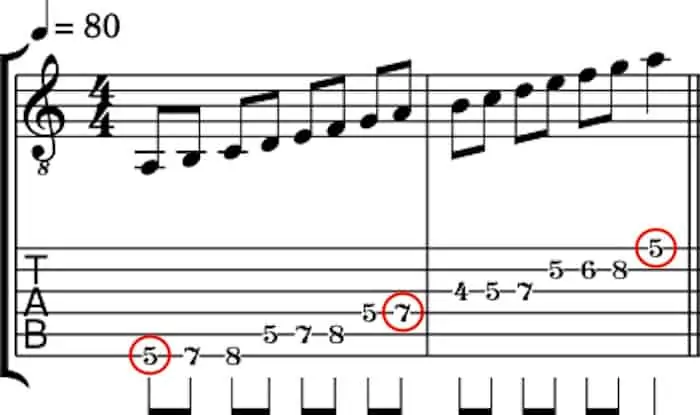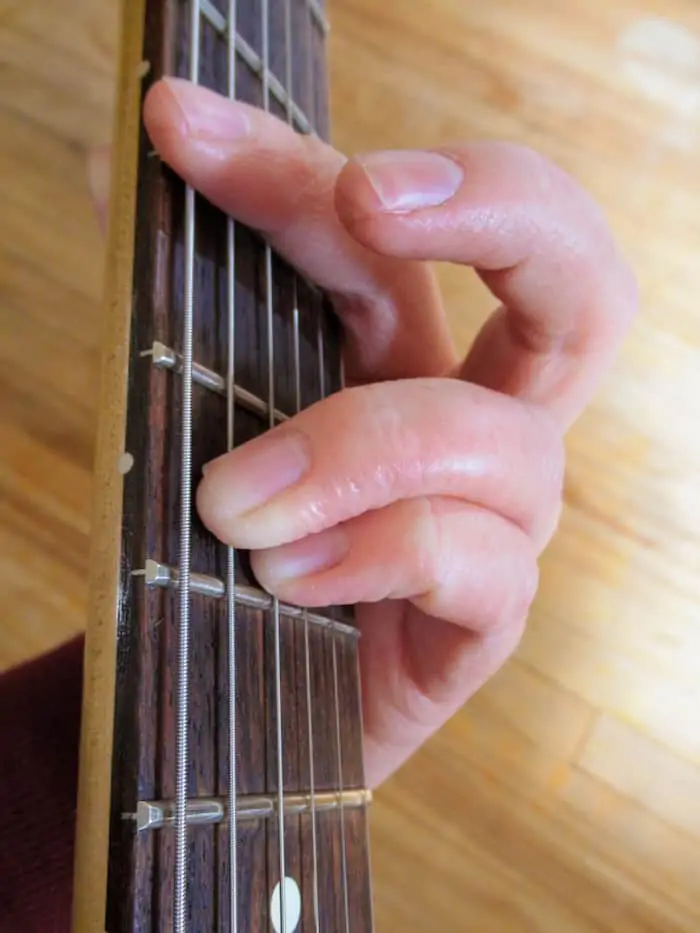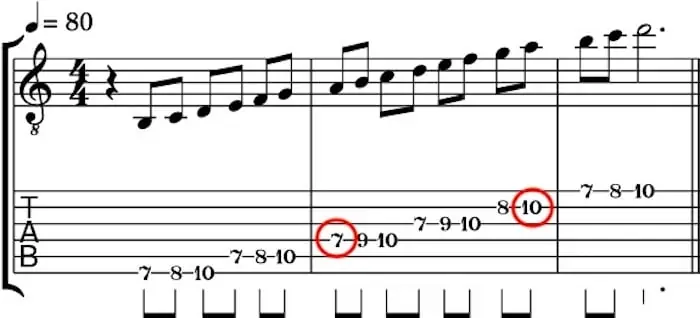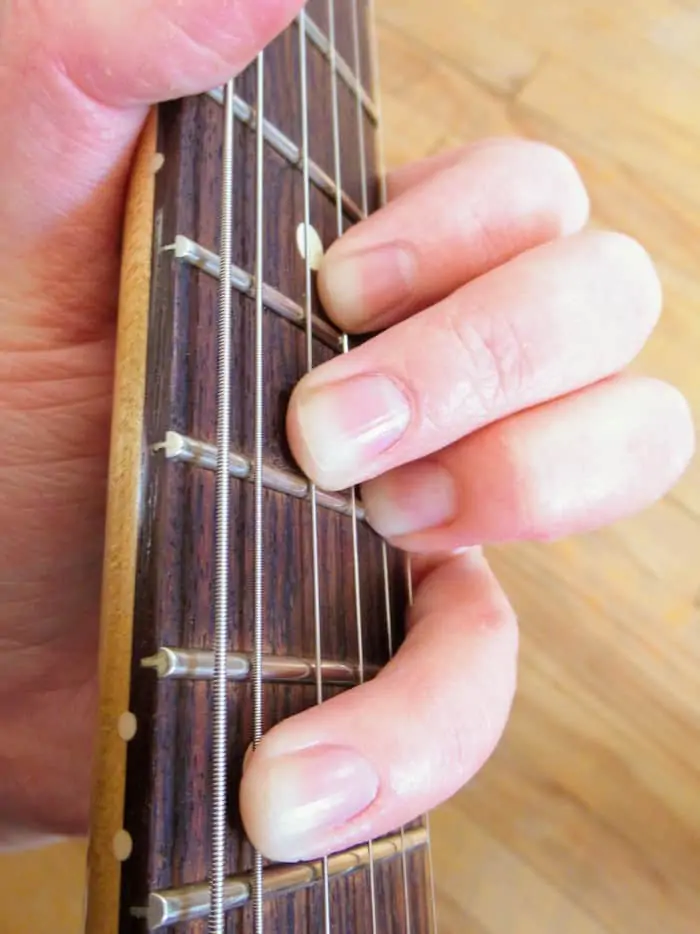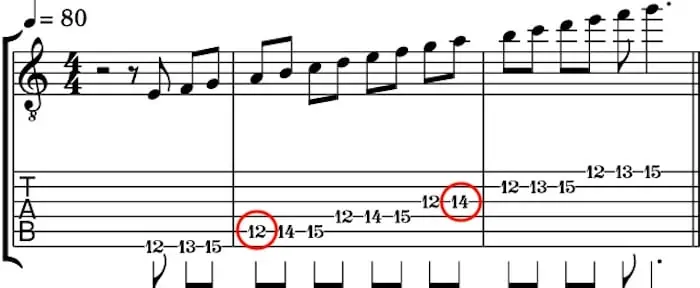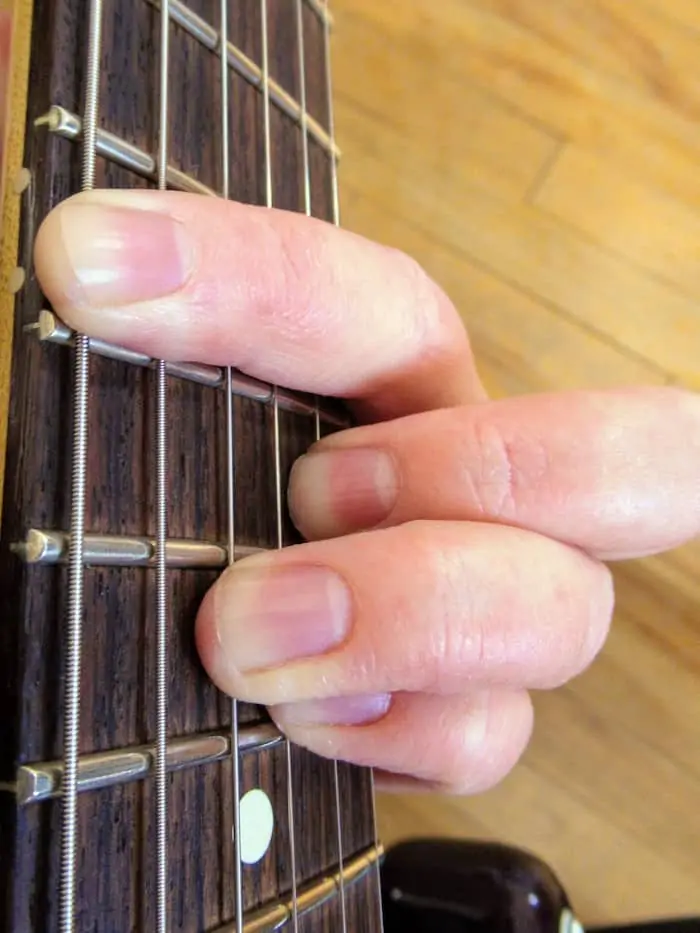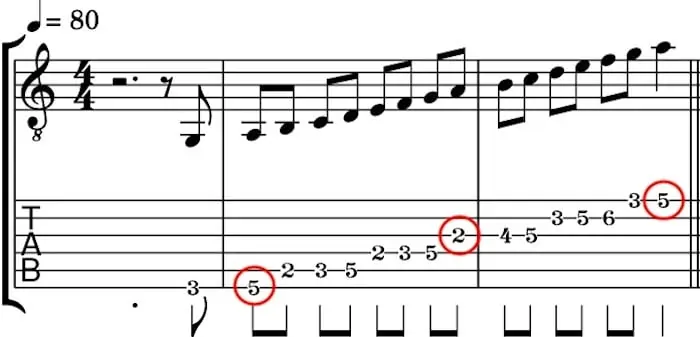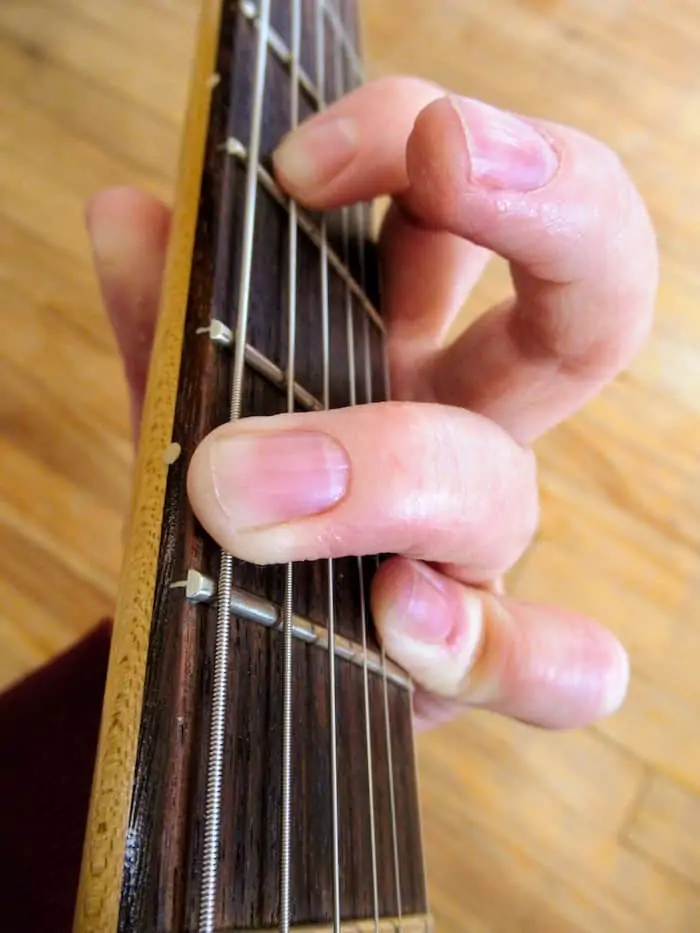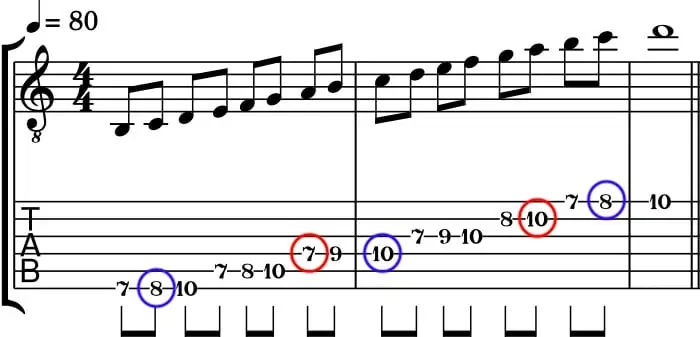At Beginner Guitar HQ, it’s our mission to help you become a better guitar player. Part of becoming a better player is learning scales –– the essential building blocks of great guitar licks, riffs and chord progressions.
The pentatonic and major scales are usually the first ones you tackle as a beginner guitarist. After that, the next step is to learn the minor scale (MS).
Also called the natural minor, classical minor or Aeolian mode, the MS is the OG choice for sad, emotional songs. You can hear it in most music genres –– from classical to metal to pop to alternative. Best of all, it can be transposed (shifted up or down the fretboard) to any key.

Once you’ve mastered the MS, you can use it to play some well-known songs–– or better yet, write your own!
Contents
First Things First
Before we dive into the MS, let’s look at the basic music theory behind it. This will help you make sense of how it’s made and how you can use those 7 notes to their full advantage.
What is a scale?
A scale is a series of notes, organized by ascending and/or descending pitch. It starts with a tonic (root note) and ends with that same tonic at a higher or lower octave (frequency).
Let’s take the A major scale. It contains 7 different notes –– A, B, C♯, D, E, F♯, G♯, A. In this ascending order, the first A note is at a lower octave than the second A. However, if we reversed the order of notes into a descending order (A, G♯, F♯, E, D, C♯, B, A), the first A is at a higher octave.
The A major scale in standard notation, ascending and descending (“A Major Scale” by Achim Raschka / CC BY-SA 3.0)
Every other note in the scale is named according to its ascending scale degree. In A major, this would make B scale degree 2, C♯ scale degree 3, and so on. To keep it simple, most guitarists call each note “the 2”, “the 3”, etc.
The spaces between scale degrees are called intervals. In ascending A major, the intervals between the tonic and the other notes are:
- A to B: major 2nd
- A to C♯: major 3rd
- A to D: perfect 4th
- A to E: perfect 5th
- A to F♯: major 6th
- A to G♯: major 7th
In the descending A major, the intervals switch directions and take on new identities:
- A to G♯: minor 2nd
- A to F♯: minor 3rd
- A to E: perfect 4th
- A to D: perfect 5th
- A to C♯: minor 6th
- A to B: minor 7th
Understanding the different intervals between scale degrees is crucial to developing your own guitar licks, as we’ll see later on…
How do you play a scale?
In Western music, there are 12 different notes you can play –– A, A♯ / B♭, B, C, C♯ / D♭, D, D♯ / E♭, E, F, F♯ / G♭, G, and G♯ / A♭. Each of these notes is a half step (also called a semitone or half tone) away from the note preceding and following it.
Chromatic scales use all 12 notes. Other types limit the number of notes you use, in order to achieve a specific sound.
The A chromatic scale, ascending.
Diatonic scales like major and minor contain the 7 notes that create the most consonance (pleasant sounds), with just a hint of dissonance (tension). They accomplish this with a pattern of two half steps and five whole steps (also called whole tones).
For example, the major scale sequence is Whole Whole Half Whole Whole Whole Half. If you apply this to the A chromatic, you get the 7 notes from A major.
On guitar fretboards, these sequences are easy to visualize. Half steps are one fret away from each other, while whole steps are two frets away
Let’s say you wanted to play the A major scale, starting on your 5th (A) string. You would begin by playing the open string. Then, you’d add a finger two frets higher for a B, two frets higher than that for a C♯, one fret higher for a D, and so on, until you reach the A octave at the 12th fret.
Keep in mind that most guitar players use three or more strings to play scales. This way, they can stay in a single position (area of the fretboard), using only 2-3 notes per string.
What is the minor scale?
Like its major cousin, the MS is a 7-note diatonic. Its formula is W H W W H W W.
If we apply this to the A chromatic, we get the following notes for A minor –– A, B, C, D, E, F, G.
The A minor scale, ascending and descending.
At first glance, you’ll notice that it shares some of the same notes as A major. However, there are three differences:
- The 3 (C♯) has been flatted (lowered) by one half step to C.
- The 6 (F♯) has been flatted by one half step to F.
- The 7 (G♯) has been flatted by one half step to G.
Because of these changes from the major sequence, these three notes are usually called the ♭3, ♭6 and ♭7.
Like other MSes, A minor contains the following ascending intervals:
- A to B: major 2nd
- A to C: minor 3rd
- A to D: perfect 4th
- A to E: perfect 5th
- A to F: minor 6th
- A to G: minor 7th
If you’re familiar with the C major scale (C, D, E, F, G, A, B), you’ll notice that the A minor scale contains the exact same notes, but in a different order. Because of this, we call A the relative minor of C.
To find the relative major of any MS, choose scale degree 3 as your tonic. And to find out the relative minor of any major scale, choose scale degree 6. For example, if we look at the A major scale (A, B, C♯, D, E, F♯, G♯), we can see that F♯ is the relative minor.
Because of this close relationship with the 6 from the major scale, the MS can be classed as a mode. A mode is a diatonic scale that contains the same notes as a major scale, but uses a different scale degree as the tonic.
Modern modes are named after the closest equivalent of ancient Greek modes (or tonoi). This is why the MS is sometimes called Aeolian mode –– after a 16th-century renaming of the ancient “Hypodorian” tonos.
Scale Patterns
Like the major and pentatonic, you can play the MS at different positions on the guitar fretboard. All you have to do is memorize some patterns.
There are two main ways to find these patterns:
- Standard approach: memorize new patterns, building off the tonic at specific locations on the 6th (low E), 5th (A) or 4th (D) strings.
- Modal approach: adapt the major scale patterns you already know to a minor tonality.
Standard approach
There are five different MS patterns you can play on guitar. Which one you use will depend on where the tonic is located.
To keep it simple, let’s stay in A minor for these examples. You can always slide the patterns up and down to try them with a different tonic.
Each pattern is based around a specific guitar chord voicing (shape) with the same root note as the tonic. This chord can either look like an open Cm, Am, Gm, Em or Dm. As a result, we call this phenomenon the “CAGED System”.
This acronym is also useful because it reminds you of the order of the chord shapes as you travel up the fretboard. For example, if the scale pattern closest to the nut looks like a Dm, the next one will look like a Cm, and so on. Even though the order of the patterns are different (depending on the tonic), the chords that they’re based on stay the same.
Pattern # 1 looks like an Em-shaped barre chord. Like the barre chord, it features the tonic as the first note on the 6th string. It ascends up the MS, ending with the octave as the second note on the 4th string. You can also continue the pattern to the next highest octave, which is the first note on the 1st (high E) string.
This is the quintessential MS pattern. So make sure you’ve got it under your belt before moving on to the others.
Pattern #1, ascending. The tonics are circled in red.
Moveable Em-shaped barre chord. Notice how the notes are derived directly from pattern #1.
Pattern #2 matches a moveable Dm-shaped chord. It begins with the tonic as the first note on the 4th string and ends with the tonic on the second note of the 2nd (B) string.
Because you’re only using three strings, this pattern may seem limiting. However, you can add some optional notes before and after the tonic to extend the pattern across the guitar fretboard.
Pattern #2, ascending
Moveable Dm voicing
As you can see, pattern #2 is an extension of the bottom notes of pattern #1. Likewise, pattern #1 is an extension of the bottom notes of pattern #5. Once you start improving, you can combine notes from different patterns at these overlaps. But for now, let’s keep looking at them in isolation.
Pattern #3 corresponds to a moveable Cm-shaped chord. It begins with the tonic as the second note on the 5th string, ending on the first note on the 2nd string. Again, you can add additional notes surrounding the tonics to extend the pattern across all 6 strings and connect it to other notes from pattern #2 or #4.
Pattern #3, ascending
Moveable Cm voicing
Pattern #3 may be less common than the others. But it still opens up some interesting guitar soloing opportunities.
Pattern #4 corresponds to a moveable Am-shaped barre chord. It features the tonic as the first note of the 5th string and the second note of the 3rd (G) string.
Pattern #4, ascending
Moveable Am-shaped barre chord
If you know your barre chords, this shape is just as easy to find as pattern #1. It also provides a seamless connection to another popular guitar pattern –– pattern #5.
Last but not least, pattern #5 roughly corresponds to a moveable Gm-shaped chord. It features the tonic as the second note of the 6th string, the first note of the 3rd string and the last note of the 1st string.
By now, we’ve gone pretty far up the guitar fretboard. You can still play this A minor pattern starting on the 15th fret of the 6th string. But to give our fingers some extra space, let’s move it back to the 3rd fret.
Pattern #5, ascending
Moveable Gm voicing
Don’t worry about memorizing everything in one go. It’s better to play one MS pattern (or even half of one pattern) really well than all five poorly.
Still, if you work your way slowly through all five, you’ll soon have the freedom to play all over the fretboard –– no matter what minor key you’re in.
This video illustrates the five MS patterns, but adapts them to G minor.
Modal approach
If you already know the five major scale patterns for guitar, you may find it easier to take these and use the 6 as your tonic instead.
Let’s look at pattern #1 from C major, which roughly corresponds to a G chord. It features the tonic on the second note of the 6th string, the last note on the 4th string and the second note of the 1st string. To extend the pattern, you can also add a 7 before the tonic on the 6th string and a 2 following the tonic on the 1st string.
Major scale pattern #1. The tonics are highlighted in blue, while the 6s are highlighted in red
To turn this major pattern into a minor pattern, all you have to do is start on the first note of the 4th string. And voilà! C major has become A minor.
As you may have noticed, major pattern #1 is the exact same shape as MS pattern #2. Major pattern #2 also matches MS pattern #3, major pattern #3 matches MS pattern #4, and so on.
In other words, it doesn’t really matter whether you decide to focus on the major or MS patterns for guitar. Either way, you’ll come out with the exact same notes. Then, all you have to do is adapt your patterns to different tonics –– and their associated CAGED chords.
What does matter is how you practice your MS patterns. The best way to do this is by alternate picking slowly up and down the pattern, with your metronome set somewhere around 40-50 BPM. Once you get comfortable with the patterns, you can gradually increase your picking speed.
How to Use It
A simple ascending or descending MS doesn’t really cut it as a compelling guitar lick. But by playing around with different intervals, rhythms and picking dynamics, you might just discover the perfect additions to your original songs.
Here are some basic rules to guide you on your MS guitar improv journey…
Do use it in minor keys
Technically, you can use the MS for a song in its relative major key. But because the tonic is different, you might be more inclined to treat the 6 as your “home” note and play around with minor intervals. As a result, you might accidentally make a happy song sound sadder and moodier than it should be.
In a minor key, however, anything is fair game. You can play around with different notes from different scale patterns, knowing that you’ve got the perfect blueprint to set the mood.
Do remember your diatonic chords
Diatonic scales are the building blocks of diatonic guitar chords. These consist of three major chords (containing a root note, 3rd note and 5th note), three minor chords (containing a root,♭3rd and 5th) and one diminished chord (containing a root, ♭3rd and ♭5th).
Each diatonic chord uses a different scale degree as the root note. If we’re working in A minor, these chords would be:
- Am (A-C-E)
- Bdim (B-D-F)
- C (C-E-G)
- Dm (D-F-A)
- Em (E-G-B)
- F (F-A-C)
- G (G-B-D)
In guitar progressions, these chords are usually listed by their Roman numerals. Capital numerals designate major chords, lowercase numerals designate minor chords and lowercase numerals with degree signs designate diminished chords. For example, an Am-Bdim-G-Am progression would be written as i-ii˚-VII-i.
You can also turn diatonic chords into 7th chords by adding the final scale degree before the root note. This will give you either a major 7th (with a natural 3rd and 7th), dominant 7th (with a natural 3rd and flatted 7th), minor 7th (with a flatted 3rd and 7th) or minor 7th flat 5 (also called a half-diminished 7th).
In A minor, the diatonic chords are:
- Am7 (A-C-E-G)
- Bm7♭5 (B-D-F-A)
- Cmaj7 (C-E-G-B)
- Dm7 (D-F-A-C)
- Em7 (E-G-B-D)
- Fmaj7 (F-A-C-E)
- G7 (G-B-D-F)
As a rhythm guitarist, knowing these diatonic chords can help you stay in key as you experiment with different progressions.
As a lead guitarist, knowing these chords can help you develop melodies to complement them. For example, you might outline the chord tones (the root, 3rd, 5th and 7th notes) as arpeggios. Or, you could add unexpected interest with the other diatonic notes (the 2nd, 4th and 6th), which are called color tones.
Don’t limit yourself to 2nd intervals
When you first learn MS patterns on guitar, it’s tempting to play them in straight ascending or descending order. While some memorable melodies are built off a few major 2nd or minor 2nd intervals, it’s much more interesting to shake things up with bigger intervallic leaps.
My suggestion? Intersperse your 2nds with some minor 3rds, perfect 4ths and perfect 5ths. Perfect 4ths and perfect 5ths are the most consonant intervals in Western music, after unisons and octaves. Minor 3rds are also the best intervals to outline the sad/mysterious tonality of the MS.
Do make use of the ♭6 and ♭7
The ♭3, ♭6 and ♭7 are the three notes that give the MS its identity. Ignoring them completely would make your melodies sound too major.
But even the ♭3 isn’t enough to highlight the identity of the natural MS. After all, any scale with a ♭3 can be called minor. By bringing out the ♭6 and ♭7, you’ll let listeners know exactly what sort of minor mood you’re going for.
For MS-based lick inspirations in a rock/metal guitar context, check out this video.
Do find your tritones
The tritone (also called the augmented 4th, diminished 5th or “devil’s interval”) is the most dissonant interval in Western music. It’s often used to add jazzy or bluesy tension to a guitar melody.
In the MS, you can find a tritone between the 2 and the ♭6. For example, in A minor, this would be B and F.
Don’t be afraid to combine it with other scales
There are tons of cool sounds to work with in a natural MS. But you can make a guitar solo even cooler by combining it with some unexpected notes from other MSes (which we’ll cover in detail a bit later).
For a blues feel, combine the natural MS with the minor blues scale. For a jazz feel, try the melodic MS. And for some Middle Eastern-influenced vibes, the harmonic MS is your best bet.
On the flip side, you can base your solos around a different kind of MS and add some telltale notes from the natural MS. This works especially well for the minor pentatonic –– the quintessential choice for rock guitar.
Don’t use it for a perfect cadence
Perfect cadences are traditional features of Western Classical music, as well as some modern guitar genres. These refer to a V-I or V7-I progression at the end of a verse, chorus or other song section.
Let’s say you have a song in the key of A major. The perfect cadence would be E7-A. More specifically, it would cover the notes E-G♯-B-D to A C♯ E.
Perfect cadences rely on a balance of consonance and dissonance. Because the E7 and A both share an E note, there is a smooth transition between these two chords. Yet, the other notes create a strong buildup of tension.
The supertonic (the 2) and especially the leading tone (the ♮7) are the two notes that create the most pull to resolve to the tonic of the home chord. In the case of A, these notes are B and G♯ –– both of which are found in the E7 chord. Even as standalone chords, dominant 7ths are much more tense than major chords, because the 3rd and ♭7th form a tritone. In short, the extreme sonic tension of the E7 leads to an even more satisfying release once it resolves to the A.
The problem with the natural MS is that we lose the perfect cadence by changing the V7 to a v7. The lowering of the G♯ note in E7 to a G in Em7 sacrifices the leading tone and the tritone. As a result, it doesn’t build up as much tension or feel as satisfying once you resolve to A.
Other types of MSes (ex: harmonic, ascending melodic) resolve this problem by raising the ♭7 to a ♮7. But if you want to stick strictly to chords from the natural MS, then you’ll have to sacrifice the possibility of a perfect cadence.
The Minor Scale in Action
Looking for more inspiration? Why not listen to famous songs that use the MS to create memorable rhythm and lead guitar parts? Some well-known examples include:
- “Losing My Religion” by R.E.M: even though it’s more mandolin-heavy than guitar-heavy, this 90s alt rock classic is the one that always comes to mind when I think of songs in a natural MS. The solo and outro lick could belong to almost any MS (it only uses the 1, ♭3, 4 and 5). However, the melancholic i-v-iv-VII chord progression puts it firmly in A minor.
- “The Trooper” by Iron Maiden: like many Iron Maiden songs, the main riff for “The Trooper” is a fine example of metal soloing in E minor. You can also hear some heavy use of the♭6 toward the end of the first guitar solo.
- “In the Air Tonight” by Phil Collins: the i-VII-VI-VII chord progression and short D minor-based guitar licks complement the moody, experimental vibes of this 80s pop tune.
- “Blackbird” by Alter Bridge: this alt metal favourite, featuring so-called “the greatest guitar solo of all time”, has a clear F# minor sound. You can also hear it in the verse melodies, thanks to the repeating ♭6 and ♭3 notes.
The natural minor-based harmonies and melodies in Alter Bridge’s “Blackbird” complement the touching lyrics about losing a loved one.
Related Scales
The Natural MS is only one type of MS. Some others you might come across are:
- Harmonic minor: a Baroque-era invention, the harmonic MS is a natural MS with a raised 7. This gives it a mysterious, Eastern-type sound, thanks to the dissonant augmented 2nd interval between the ♭6 and ♮7. On the plus side, its diatonic guitar chords can create a perfect cadence.
- Melodic minor: the melodic MS was created to maintain the perfect cadence of the harmonic MS, but remove the augmented 2nd interval. When ascending, it raises the 6, creating a ♮6 and ♮7. When descending, it lowers the 7, creating a ♭6 and ♭7. As you can see, the descending melodic MS is exactly the same as the natural MS.
- Jazz minor: another name for the ascending melodic MS, this is a favorite in jazz and fusion guitar styles.
- Hungarian minor: also called the double harmonic MS or Gypsy MS, this is similar to the natural MS, but contains a #4 and ♮7. As a result, it contains two augmented 2nd intervals, amping up the dissonance for Western ears.
- Minor pentatonic: as the name suggests, this is a 5-note instead of a 7-note scale. It’s essentially a natural MS without the 2 and ♭6. By axing the half step intervals, it lends itself to smoother, more consonant guitar licks.
- Minor blues: blues scales are pentatonics with an additional chromatic note –– in this case, the ♭5. This creates a tritone with the tonic, leading to some moody, Delta-inspired dissonance.
- Dorian: this mode is basically a natural MS with a ♮6. It is based on the 2 of the major scale.
- Phrygian: like Dorian, this mode is almost identical to the natural MS, but contains a ♭2. It is based on the 3 of the major scale.
- Locrian: rarely used for guitar music, this mode is a natural MS with an additional ♭2 and ♭5. It is based on the 7 of the major scale.
Each 7-note type of MS also has its associated diatonic chords. For example, the ♮7 in the harmonic MS turns the III into an augmented chord (with a raised 5th note), the v into a dominant 7th chord and the VII into a diminished chord (Cropped from “Harmonic minor scale in A-minor” by Kevicoll / CC BY-SA 3.0).
Final Thoughts
Whether you’re brand new to guitar scales or just looking for a challenge beyond the pentatonics, learning the MS can help you take your rhythm and lead guitar playing to the next level.
It may seem tedious to memorize all of these scale patterns and improv guidelines. But trust me. It’s worth it!
Having fun is the most important bit. So don’t be afraid to get creative and add your own style to MS scale patterns, licks and chord progressions
Who knows? You might just discover a new kick*ss guitar lick for that song you’ve been working on for weeks.




